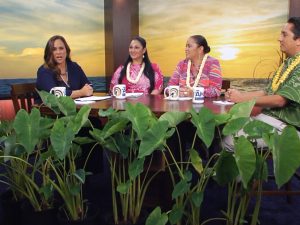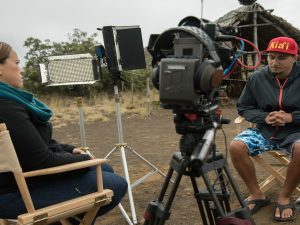View the complete unedited raw footage.
The battle against the Thirty Meter Telescope on Maunakea is not only being waged in protests on the mauna or on the streets of Waikīkī.
The Hawaiʻi Supreme Court heard oral arguments today for a case challenging the issuance of the Conservation District Use Permit by the Board of Land and Natural Resources to the University of Hawaiʻi at Hilo for the TMT project.
“Today was almost the final step in the appeals process,” said Camille Kalama, of the Native Hawaiian Legal Corp. “So today was about the attorneys for each side to argue what was wrong with what happened before the Board of Land and Natural Resources when they initially issued a permit and had a contested case hearing.”
“So it’s not a chance for the Justices to hear from witnesses or hear new evidence. They are looking at what was before the Board at the time the decision was made and just the attorneys’ arguments about why what happened was wrong,” continued Kalama.
The case focuses on four main arguments:
-The first being a due process issue given that BLNR approved the use permit despite a pending contested case hearing.
-The second questions whether the use application met the eight criteria necessary for allowing development within a conservation district.
-The third states that the permit was subject to an insufficient management plan for the mountain.
-The fourth deals with the flawed analysis and mitigation of impacts to cultural, natural, and historical resources.
Kalama added, “Today we heard all of them asking many difficult questions and really giving a lot of time to allow the attorneys to argue and for them to really get a complete record to have all their questions answered.”
Jay S. Handlin, attorney for the University of Hawaiʻi, said, “What was encouraging for everybody is that this is a very interested court. Really paying attention. Everybody came in prepared. Everybody up there had questions.”
Kalama said, “The court is very concerned with due process, making sure that the parties, especially the petitioners get a fair hearing and this is not the first case to come up on this process where the Board issues a permit and then holds a hearing. You heard the attorneys for UH try to distinguish between the Kilakila process and what happened here. Prior to 2009, if a contested case request was made all Board discussion was halted and they would go into contested case mode. So this is definitely a very new and concerning practice that our office fought in the Kilakila case and the court agreed that it was flawed.”
In addition to the discussion of due process, Justice Wilson also asked repeatedly for the attorneys to address the issue of substantial adverse impact to the conservation district.
Richard Nāiwiʻehā Wurdeman, attorney for the petitioners, said, “The fact that the TMT project doesn’t meet any of the criteria to be developed in a conservation district that’s certainly something that we strongly advocate about. I feel good that we did the best job we could and we have faith in the court that the court will come to a just determination.”
Handlin added, “They were interested, they were informed, they are going to take what they heard today, go back, think about it, go back and read the papers, and come to their decision. I think the university would like to go ahead and have the TMT built. I think the university has worked hard to really address concerns and I think that they would like to go ahead and have the project proceed.”
Nāiwiʻehā concluded, “I think certainly the TMT shouldn’t be built at all. You heard the arguments about substantial and adverse impacts on Maunakea. There’s a lot of work to be done up on Maunakea to start bringing it back to what it needs to be. To make it clean and pono up there, we need to start decommissioning telescopes, cleaning up the area, and start having more respect for the practice of culture on Maunakea.”



